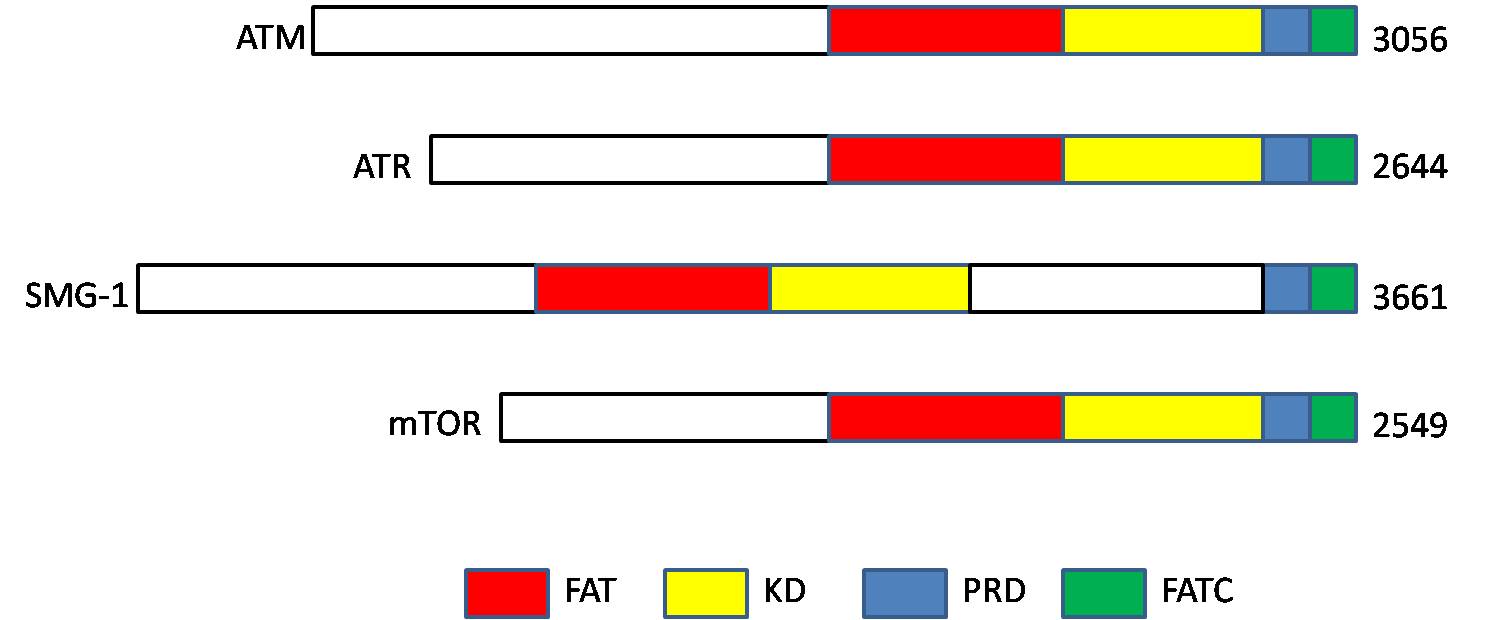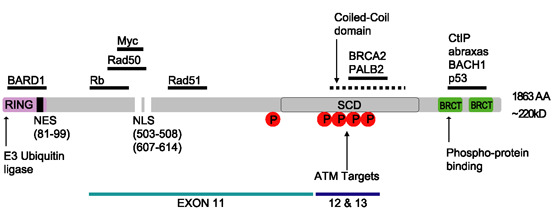|
RBBP8
Retinoblastoma-binding protein 8 is a protein that in humans is encoded by the ''RBBP8'' gene. Function The protein encoded by this gene is a ubiquitously expressed nuclear protein. It is found among several proteins that bind directly to retinoblastoma protein, which regulates cell proliferation. This protein complexes with transcriptional co-repressor CTBP. It is also associated with BRCA1 and is thought to modulate the functions of BRCA1 in transcriptional regulation, DNA repair, and/or cell cycle checkpoint control. It is suggested that this gene may itself be a tumor suppressor acting in the same pathway as BRCA1. Three transcript variants encoding two different isoforms have been found for this gene. More transcript variants exist, but their full-length natures have not been determined. Interactions RBBP8 has been shown to interact with: * ATM, * BRCA1, * CTBP1, * LMO4, * RB1, * RBL1, * RBL2, and * SIAH1 E3 ubiquitin-protein ligase SIAH1 is an enzyme that in ... [...More Info...] [...Related Items...] OR: [Wikipedia] [Google] [Baidu] |
Ataxia Telangiectasia Mutated
ATM serine/threonine kinase or Ataxia-telangiectasia mutated, symbol ATM, is a serine/threonine protein kinase that is recruited and activated by DNA double-strand breaks. It phosphorylates several key proteins that initiate activation of the DNA damage checkpoint, leading to cell cycle arrest, DNA repair or apoptosis. Several of these targets, including p53, CHK2, BRCA1, NBS1 and H2AX are tumor suppressors. In 1995, the gene was discovered by Yosef Shiloh who named its product ATM since he found that its mutations are responsible for the disorder ataxia–telangiectasia#Cause, ataxia–telangiectasia. In 1998, the Shiloh and Michael B. Kastan, Kastan laboratories independently showed that ATM is a protein kinase whose activity is enhanced by DNA damage. Introduction Throughout the cell cycle DNA is monitored for damage. Damages result from errors during DNA replication, replication, by-products of metabolism, general toxic drugs or ionizing radiation. The cell cycle has diffe ... [...More Info...] [...Related Items...] OR: [Wikipedia] [Google] [Baidu] |
BRCA1
Breast cancer type 1 susceptibility protein is a protein that in humans is encoded by the ''BRCA1'' () gene. Orthologs are common in other vertebrate species, whereas invertebrate genomes may encode a more distantly related gene. ''BRCA1'' is a human tumor suppressor gene (also known as a caretaker gene) and is responsible for repairing DNA. ''BRCA1'' and '' BRCA2'' are unrelated proteins, but both are normally expressed in the cells of breast and other tissue, where they help repair damaged DNA, or destroy cells if DNA cannot be repaired. They are involved in the repair of chromosomal damage with an important role in the error-free repair of DNA double-strand breaks. If ''BRCA1'' or ''BRCA2'' itself is damaged by a BRCA mutation, damaged DNA is not repaired properly, and this increases the risk for breast cancer. ''BRCA1'' and ''BRCA2'' have been described as "breast cancer susceptibility genes" and "breast cancer susceptibility proteins". The predominant allele has a normal, ... [...More Info...] [...Related Items...] OR: [Wikipedia] [Google] [Baidu] |
CTBP1
C-terminal-binding protein 1 also known as CtBP1 is a protein that in humans is encoded by the ''CTBP1'' gene. CtBP1 is one of two CtBP proteins, the other protein being CtBP2. Function The CtBP1 protein was originally identified as a human protein that bound a PLDLS motif in the C-terminus of adenovirus E1A proteins. It and the related protein CTBP2 were later shown to function as transcriptional corepressors. That is, regulatory proteins that bind to sequence-specific DNA-binding proteins and help turn genes off. CtBPs do this by recruiting histone modifying enzymes that add repressive histone marks and remove activating marks. CtBP proteins can also self-associate and presumably bring together gene regulatory complexes. CtBP1 is broadly expressed from embryo to adult, while CtBP2 has a somewhat more restricted pattern of expression. CtBPs have multiple biological roles and appear to be most important in regulating the epithelial to mesenchymal transition, as well as influencing ... [...More Info...] [...Related Items...] OR: [Wikipedia] [Google] [Baidu] |
LMO4
LIM domain transcription factor LMO4 is a protein that in humans is encoded by the ''LMO4'' gene. LIM domain only 4 is a cysteine-rich, two LIM domain-containing protein that may play a role as a transcriptional regulator or possibly an oncogene. Its mRNA is characterized by a GC-rich 5' region and by multiple ATTT motifs in the 3' region. A variant transcript missing a portion of the 5' region has been identified but cannot be confirmed because of the GC-rich nature of the region. Interactions LMO4 has been shown to Protein-protein interaction, interact with LDB1, RBBP8 and BRCA1. References Further reading * * * * * * * * * * * * * * * {{Gene-1-stub ... [...More Info...] [...Related Items...] OR: [Wikipedia] [Google] [Baidu] |
Retinoblastoma Protein
The retinoblastoma protein (protein name abbreviated pRb; gene name abbreviated ''Rb'', ''RB'' or ''RB1'') is a proto-oncogenic tumor suppressor protein that is dysfunctional in several major cancers. One function of pRb is to prevent excessive cell growth by inhibiting cell cycle progression until a cell is ready to divide. When the cell is ready to divide, pRb is phosphorylated, inactivating it, and the cell cycle is allowed to progress. It is also a recruiter of several chromatin remodeling enzymes such as methylases and acetylases. pRb belongs to the pocket protein family, whose members have a pocket for the functional binding of other proteins. Should an oncogenic protein, such as those produced by cells infected by high-risk types of human papillomavirus, bind and inactivate pRb, this can lead to cancer. The ''RB'' gene may have been responsible for the evolution of multicellularity in several lineages of life including animals. Name and genetics In humans, the prote ... [...More Info...] [...Related Items...] OR: [Wikipedia] [Google] [Baidu] |
Retinoblastoma-like Protein 1
Retinoblastoma-like 1 (p107), also known as RBL1, is a protein that in humans is encoded by the ''RBL1'' gene. Function The protein encoded by this gene is similar in sequence and possibly function to the product of the retinoblastoma 1 ( RB1) gene. The RB1 gene product is a tumor suppressor protein that appears to be involved in cell cycle regulation, as it is phosphorylated in the S to M phase transition and is dephosphorylated in the G1 phase of the cell cycle. Both the RB1 protein and the product of this gene can form a complex with adenovirus E1A protein and SV40 Large T-antigen, with the SV40 large T-antigen binding only to the unphosphorylated form of each protein. In addition, both proteins can inhibit the transcription of cell cycle genes containing E2F binding sites in their promoters. Due to the sequence and biochemical similarities with the RB1 protein, it is thought that the protein encoded by this gene may also be a tumor suppressor. Two transcript variants enco ... [...More Info...] [...Related Items...] OR: [Wikipedia] [Google] [Baidu] |
Retinoblastoma-like Protein 2
Retinoblastoma-like protein 2 is a protein that in humans is encoded by the ''RBL2'' gene. Interactions Retinoblastoma-like protein 2 has been shown to interact with: * BRCA1, * BRF1 * C-Raf, * Cyclin E1, * Cyclin-dependent kinase 2, * HDAC1, * Prohibitin Prohibitin, also known as PHB, is a protein that in humans is encoded by the ''PHB'' gene. The ''Phb'' gene has also been described in animals, fungi, plants, and unicellular eukaryotes. Prohibitins are divided in two classes, termed Type-I and Ty ..., and * RBBP8. See also * Pocket protein family References Further reading * * * * * * * * * * * * * * * * * * External links * {{DEFAULTSORT:Retinoblastoma-Like Protein 2 Transcription factors ... [...More Info...] [...Related Items...] OR: [Wikipedia] [Google] [Baidu] |
Protein
Proteins are large biomolecules and macromolecules that comprise one or more long chains of amino acid residues. Proteins perform a vast array of functions within organisms, including catalysing metabolic reactions, DNA replication, responding to stimuli, providing structure to cells and organisms, and transporting molecules from one location to another. Proteins differ from one another primarily in their sequence of amino acids, which is dictated by the nucleotide sequence of their genes, and which usually results in protein folding into a specific 3D structure that determines its activity. A linear chain of amino acid residues is called a polypeptide. A protein contains at least one long polypeptide. Short polypeptides, containing less than 20–30 residues, are rarely considered to be proteins and are commonly called peptides. The individual amino acid residues are bonded together by peptide bonds and adjacent amino acid residues. The sequence of amino acid residue ... [...More Info...] [...Related Items...] OR: [Wikipedia] [Google] [Baidu] |
Gene
In biology, the word gene (from , ; "...Wilhelm Johannsen coined the word gene to describe the Mendelian units of heredity..." meaning ''generation'' or ''birth'' or ''gender'') can have several different meanings. The Mendelian gene is a basic unit of heredity and the molecular gene is a sequence of nucleotides in DNA that is transcribed to produce a functional RNA. There are two types of molecular genes: protein-coding genes and noncoding genes. During gene expression, the DNA is first copied into RNA. The RNA can be directly functional or be the intermediate template for a protein that performs a function. The transmission of genes to an organism's offspring is the basis of the inheritance of phenotypic traits. These genes make up different DNA sequences called genotypes. Genotypes along with environmental and developmental factors determine what the phenotypes will be. Most biological traits are under the influence of polygenes (many different genes) as well as gen ... [...More Info...] [...Related Items...] OR: [Wikipedia] [Google] [Baidu] |




